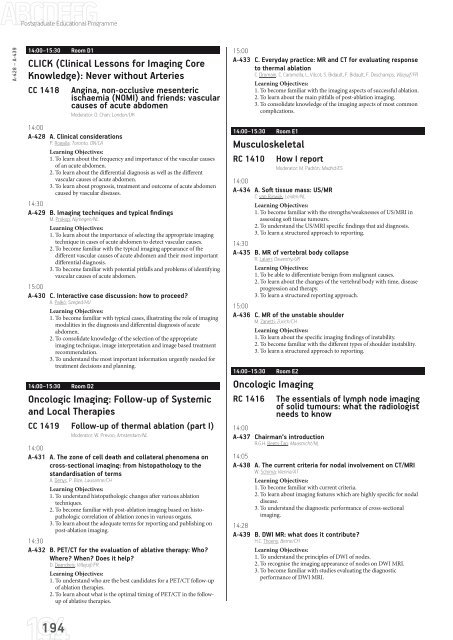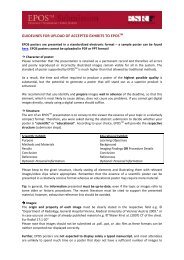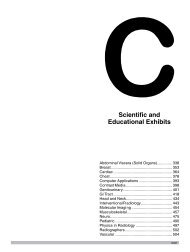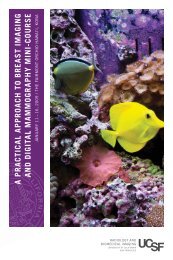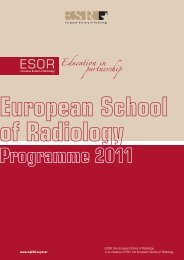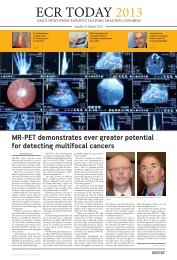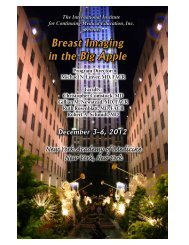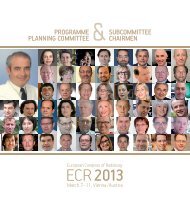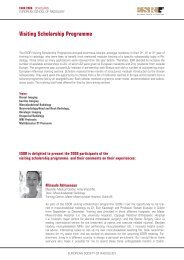ECR 2013 â Final Programme - myESR.org
ECR 2013 â Final Programme - myESR.org
ECR 2013 â Final Programme - myESR.org
- No tags were found...
You also want an ePaper? Increase the reach of your titles
YUMPU automatically turns print PDFs into web optimized ePapers that Google loves.
Postgraduate Educational <strong>Programme</strong>A-428 – A-43914:00–15:30 Room D1CLICK (Clinical Lessons for Imaging CoreKnowledge): Never without ArteriesCC 1418 Angina, non-occlusive mesentericischaemia (NOMI) and friends: vascularcauses of acute abdomenModerator: O. Chan; London/UK14:00A-428 A. Clinical considerationsP. Rogalla; Toronto, ON/CALearning Objectives:1. To learn about the frequency and importance of the vascular causesof an acute abdomen.2. To learn about the differential diagnosis as well as the differentvascular causes of acute abdomen.3. To learn about prognosis, treatment and outcome of acute abdomencaused by vascular diseases.14:30A-429 B. Imaging techniques and typical findingsM. Prokop; Nijmegen/NLLearning Objectives:1. To learn about the importance of selecting the appropriate imagingtechnique in cases of acute abdomen to detect vascular causes.2. To become familiar with the typical imaging appearance of thedifferent vascular causes of acute abdomen and their most importantdifferential diagnosis.3. To become familiar with potential pitfalls and problems of identifyingvascular causes of acute abdomen.15:00A-430 C. Interactive case discussion: how to proceed?A. Palkó; Szeged/HULearning Objectives:1. To become familiar with typical cases, illustrating the role of imagingmodalities in the diagnosis and differential diagnosis of acuteabdomen.2. To consolidate knowledge of the selection of the appropriateimaging technique, image interpretation and image based treatmentrecommendation.3. To understand the most important information urgently needed fortreatment decisions and planning.14:00–15:30 Room D2Oncologic Imaging: Follow-up of Systemicand Local TherapiesCC 1419 Follow-up of thermal ablation (part I)Moderator: W. Prevoo; Amsterdam/NL14:00A-431 A. The zone of cell death and collateral phenomena oncross-sectional imaging: from histopathology to thestandardisation of termsA. Denys, P. Bize; Lausanne/CHLearning Objectives:1. To understand histopathologic changes after various ablationtechniques.2. To become familiar with post-ablation imaging based on histopathologiccorrelation of ablation zones in various <strong>org</strong>ans.3. To learn about the adequate terms for reporting and publishing onpost-ablation imaging.14:30A-432 B. PET/CT for the evaluation of ablative therapy: Who?Where? When? Does it help?D. Deandreis; Villejuif/FRLearning Objectives:1. To understand who are the best candidates for a PET/CT follow-upof ablation therapies.2. To learn about what is the optimal timing of PET/CT in the followupof ablative therapies.15:00A-433 C. Everyday practice: MR and CT for evaluating responseto thermal ablationC. Dromain, C. Caramella, L. Vilcot, S. Bidault, F. Bidault, F. Deschamps; Villejuif/FRLearning Objectives:1. To become familiar with the imaging aspects of successful ablation.2. To learn about the main pitfalls of post-ablation imaging.3. To consolidate knowledge of the imaging aspects of most commoncomplications.14:00–15:30 Room E1MusculoskeletalRC 1410 How I reportModerator: M. Padrón; Madrid/ES14:00A-434 A. Soft tissue mass: US/MRC. van Rijswijk; Leiden/NLLearning Objectives:1. To become familiar with the strengths/weaknesses of US/MRI inassessing soft tissue tumours.2. To understand the US/MRI specific findings that aid diagnosis.3. To learn a structured approach to reporting.14:30A-435 B. MR of vertebral body collapseR. Lalam; Oswestry/UKLearning Objectives:1. To be able to differentiate benign from malignant causes.2. To learn about the changes of the vertebral body with time, diseaseprogression and therapy.3. To learn a structured reporting approach.15:00A-436 C. MR of the unstable shoulderM. Zanetti; Zurich/CHLearning Objectives:1. To learn about the specific imaging findings of instability.2. To become familiar with the different types of shoulder instability.3. To learn a structured approach to reporting.14:00–15:30 Room E2Oncologic ImagingRC 1416 The essentials of lymph node imagingof solid tumours: what the radiologistneeds to know14:00A-437 Chairman‘s introductionR.G.H. Beets-Tan; Maastricht/NL14:05A-438 A. The current criteria for nodal involvement on CT/MRIW. Schima; Vienna/ATLearning Objectives:1. To become familiar with current criteria.2. To learn about imaging features which are highly specific for nodaldisease.3. To understand the diagnostic performance of cross-sectionalimaging.14:28A-439 B. DWI MR: what does it contribute?H.C. Thoeny; Berne/CHLearning Objectives:1. To understand the principles of DWI of nodes.2. To recognise the imaging appearance of nodes on DWI MRI.3. To become familiar with studies evaluating the diagnosticperformance of DWI MRI.194


